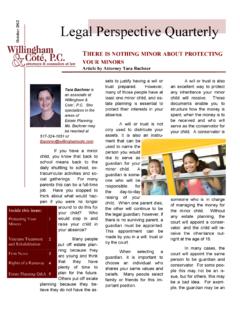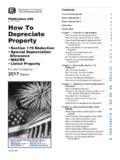Transcription of AvoidingTheBiggestMistakesReal …
1 Avoiding The Biggest Mistakes RealEstate Owners Make When DealingWith Partners and InvestorsCopyright 2003 West Group. Reprinted with permission. Originally appeared in the Summer 2003 issue of RealEstate Finance Journal. For more information on that publication, please visit rey H. LermanEven seasoned investors make certain mistakes that have potentially expensiveand devastating consequences to the very investment that brought themtogether. In this article, Je rey H. Lerman explores some of the biggest of some point in every real estate investor's career, heor she most likely will end up dealing with a partner orinvestor.
2 Combining resources with a co-venturer canyield many bene ts: a source of expertise that mayotherwise be lacking, somebody to share and hedge theinevitable risks accompanying real estate investment,and additional capital to name a few. Yet in starting upthese mini-businesses (after all, real estate invest-ment is a business), it is surprising how often evenseasoned investors make certain mistakes that havepotentially expensive and devastating consequences tothe very investment that brought them together. Thisarticle explores some of the biggest of those v. InvestorAt the outset, it is important to de ne and distinguish partners and investors.
3 Although two people get-ting together to own real estate may ultimately structuretheir venture in something other than a general partner-ship ( , a limited liability company, a limited part-nership or a corporation), for convenience this articlewill refer to these co-venturers simply as partners. For purposes of this article, investors are solelyinvestors of money (although many investors haveearned their place in a deal by investing soft dollars in the form of real estate broker commissions, equityin the real estate that forms the basis of the deal, or sweat equity ).
4 In the context of the securities laws,these investors would be called passive investors. The signi cance of this distinction will Set-UpAssume two individuals have decided to collaborateon an investment. One of them, Jack Hammer, is a gen-eral contractor who found a great deal an existingapartment building with upside potential if certainimprovements can be made but lacks the necessarycapital and expertise to acquire and operate theinvestment. The other, Rich Green, is a seasoned, suc-cessful real estate investor with deep pockets. This is atypical scenario and provides the backdrop for thisdiscussion.
5 #1 Not protecting personal assets by hold-ing title in an entityMany partners hold property as either tenants-in-Je rey H. Lerman, a lawyer, investor and real estate broker is a co-founder of Lerman & Lerman. Co-chair of the Marin County Bar As-sociation Real Estate Section, Mr. Lerman may be reached atje REAL ESTATE FINANCE JOURNAL/SUMMER 20031@MAGNETO/VENUS/PAMPHLET02/ATTORNEY/ REFJ/LERMNCPY SESS: 1 COMP: 06/10/03PG. POS: 1common or general partners (either by intentionallyforming a general partnership or, by doing nothing, nding themselves in ade factopartnership).
6 This ispotentially a huge mistake as each partner is jointlyand severally liable to the full extent of the law and allof their individual assets are fully exposed and atrisk not only for their own misconduct but also forthe misconduct of their partner! Accordingly, the rstand perhaps the most important decision partners mustmake is whether to form an entity to maximize protec-tion of their personal an asset protection entity always advisable? Gen-erally speaking, yes. However, this is a business deci-sion the clients must ultimately make themselves. Nomatter how large or small the investment, partnersshould conduct the following analysis:(1) estimate all potential maximum liabilities as-sociated with the investment ( , personal injury, re, earthquake, contractual lawsuits from tenants,vendors, contractors, etc.)
7 ;(2) determine how much of these liabilities may beinsured against (caveat: an insurance policy is noguarantee of payment if a claim is submitted; thecourts are lled with insureds' lawsuits for alleg-edly improper carrier denials of claims);(3) evaluate all remaining potential liability, and;(4) engage in a cost-bene t analysis to determine ifthe cost of setting up and maintaining an entity isworth the asset protection bene ts an entity virtually all cases, this analysis will probablyresult in the conclusion that an entity makes sense;while an insurance company may deny an insured'sclaim, a properly formed and maintained entity shouldalways give precisely the protection expected.
8 #2 Not identifying con icts of interestbefore hiring the same lawyerIn the example, Rich and Jack have very di erentcircumstances. Those di erences may result in mate-rial con icts of interest. For example, they may havedi erent tax objectives. Rich may be looking for, or atleast have no problem with, losses as they may providea shelter for his other income. Jack, on the other hand,probably needs his rst deal to be a winner. Theymost certainly have di erent abilities to contributecapital. Rich is the deep pocket while Jack has only sweat equity to contribute.
9 They very well mayhave di erent holding period preferences. Rich may bea buy and hold investor while Jack may want aquick turn to leverage into his next investment. Simi-larly, Rich and Jack may have con icting exitstrategies. Rich may want to e ect a 1031 exchangewhile Jack may want to pull his money out for otherpurposes. With these types of con icts, it may be amistake for Rich and Jack to hire the same attorney; asingle lawyer representing both parties will probablynot represent either side as aggressively as she wouldif she represented just one of the this mean partners should always hire sepa-rate counsel?
10 No. On many occasions, one lawyer isstill retained for joint representation (with appropriatedisclosures of con icts of interest by the attorney andsigned waivers of those con icts by the clients). Thisis consistent with the collaborative, non-adversarialspirit that brought the individuals together in the rstplace and keeps fees down. However, it is essential torecognize and discuss these con icts thoroughly tominimize surprises later.#3 Not getting tax advice upfrontThe decision as to how to how to do business withpartners is as much tax-driven as it is erent ownership structures, with their myriad of is-sues involving contributions, pro ts and losses, allhave their own tax implications.






